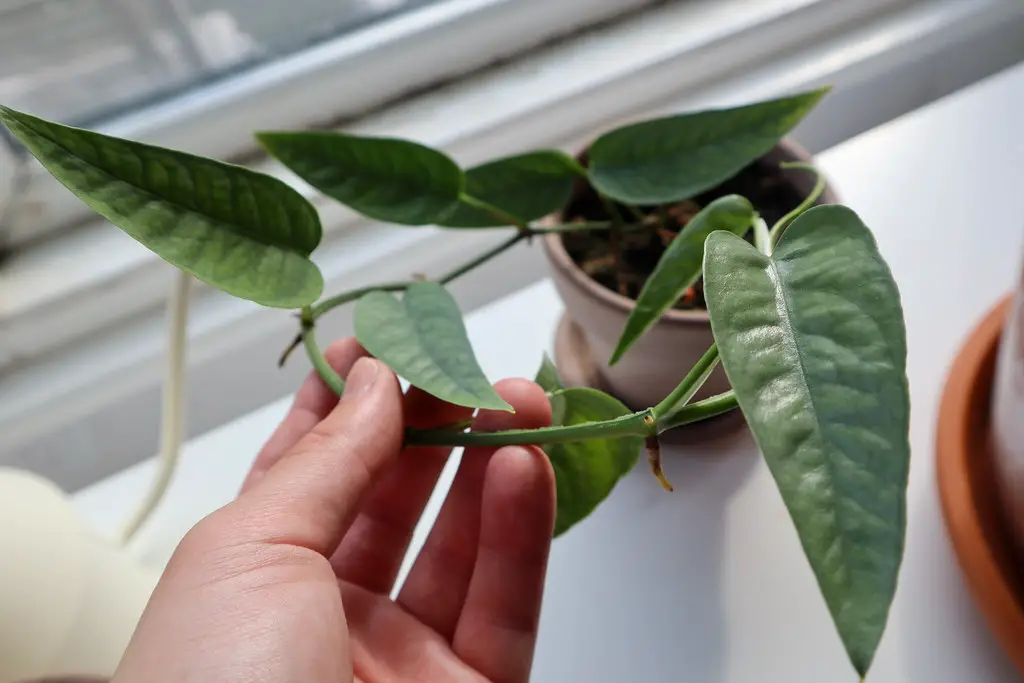Cebu Blue Pothos, a stunning tropical vine, adds a touch of the exotic to any indoor setting. Named after the island of Cebu in the Philippines, where it’s believed to be native, this plant is renowned for its beautiful, silvery-blue, elongated leaves. The color and unique sheen of the foliage set it apart from other members of the Pothos family.
The plant’s easy-going nature and ability to thrive in various indoor conditions make it a favorite among houseplant enthusiasts. It can grow in low to bright indirect light, and it’s forgiving of occasional neglect, making it suitable for those new to plant care. Its cascading vines are often featured in hanging baskets or allowed to climb, where they can create an eye-catching focal point.
Despite its robust growth, Cebu Blue Pothos does require some attention to look its best. Its care involves proper light, watering, and regular feeding. Understanding its native tropical environment helps in providing the conditions it needs to flourish. Here’s an in-depth look at this beautiful vine, including its requirements, common problems, and care tips.
| Attribute | Details |
|---|---|
| Common Names | Cebu Blue Pothos |
| Botanical Name | Epipremnum pinnatum ‘Cebu Blue’ |
| Family | Araceae |
| Plant Type | Tropical Vine |
| Mature Size | 6-12 feet |
| Sun Exposure | Low to Bright Indirect Light |
| Soil Type | Well-draining Potting Mix |
| Hardiness Zones | 10-11 (indoors) |
| Native Area | Philippines |
Cebu Blue Pothos Care
Cebu Blue Pothos, being a tropical vine, appreciates a warm, humid environment. It can adapt to different lighting conditions but thrives best in bright, indirect sunlight. Watering should be moderate; it’s best to allow the soil to dry slightly between waterings to avoid overwatering.
While it’s relatively low-maintenance, this plant benefits from regular feeding during the growing season and occasional pruning to maintain its shape. Providing a support structure, such as a trellis, can allow the plant to climb, revealing its true potential and displaying its beautiful trailing vines.
Light Requirement for Cebu Blue Pothos
Cebu Blue Pothos does well in low to bright indirect light. While it can tolerate lower light levels, providing bright, filtered sunlight will encourage more robust growth and more vibrant coloration in the leaves.
Soil Requirements for Cebu Blue Pothos
A well-draining potting mix is ideal for Cebu Blue Pothos. Mixing general-purpose potting soil with perlite or sand can enhance drainage, preventing root rot. The soil should retain some moisture but not become waterlogged.
Water Requirements for Cebu Blue Pothos
Watering should be consistent but not excessive. Allow the top inch of soil to dry between waterings, then water thoroughly. Reduce watering during the winter months when growth slows down.
Temperature and Humidity
Cebu Blue Pothos prefers temperatures between 65-85°F (18-30°C). It can tolerate lower temperatures but may suffer in prolonged cold. Humidity levels around 40-60% are ideal, and misting or a humidity tray can help maintain this level, especially in dry indoor environments.
Fertilizer
Feed Cebu Blue Pothos with a balanced, liquid houseplant fertilizer every 4-6 weeks during the growing season (spring and summer). Avoid over-fertilizing, as it may cause salt buildup in the soil.
Pruning Cebu Blue Pothos
Regular pruning helps maintain the shape of the plant and encourages bushier growth. Trim back long or leggy vines and remove any yellow or damaged leaves as needed.
Propagating Cebu Blue Pothos
Propagation is easily done through stem cuttings. Cut a 4-6 inch section with at least one leaf and place it in water or moist soil. Roots should appear in a few weeks, and the cutting can be planted.
How To Grow Cebu Blue Pothos From Seed
Growing Cebu Blue Pothos from seed is less common, and seeds may be hard to find. If attempting this method, follow the instructions provided on the seed packet.
Common Pests & Plant Diseases
Spider Mites
Tiny insects that may cause webbing and speckling on leaves.
Root Rot
Caused by overwatering, leading to soggy soil and rotting roots.
Common Problems With Cebu Blue Pothos
Yellowing Leaves
Often a sign of overwatering, adjust watering habits accordingly.
Lack of Growth
May indicate insufficient light, move the plant to a brighter location.
Pro Tips
- Use a support like a trellis to encourage climbing growth.
- Rotate the pot occasionally to ensure even growth and exposure to light.
- Check for pests regularly, especially under the leaves.
- Pair with other tropical plants for a lush, jungle-like feel.
- Mist leaves occasionally to mimic tropical humidity.




